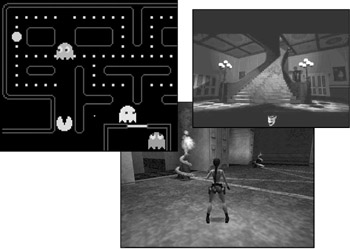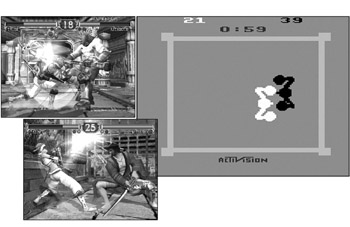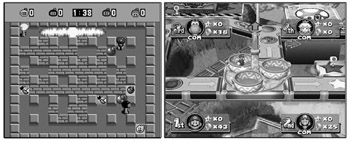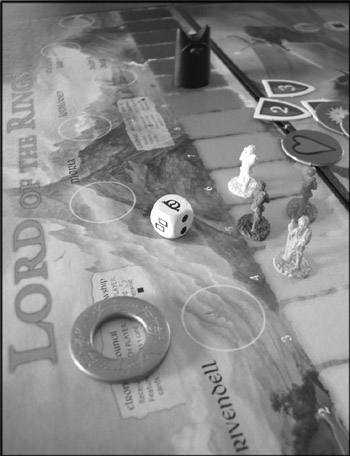Players
|
| < Day Day Up > |
|
It’s obvious that games are experiences designed for players, and that without players, games have no reason to exist. It’s not as obvious how to structure the involvement of those players in your game. This is one of the key decisions you need to make as a designer. For instance, how many players does the game require? How many total players can the game support? Do various players have different roles? Will they compete, cooperate, or both? The way you answer these questions will change the overall design of your game.
Exercise 3.2: Three-Player Tic-tac-toe
Create a version of tic-tac-toe that works for three players. You may need to change the size of the board or other elements of the game to do this.
Roles of players

Figure 3.1: Costumed players at an EverQuest convention
Most games have uniform roles for all players. In chess and Monopoly, there is only one role for all players. But some games have more than one role for players to choose between. In Mastermind, one player chooses to be the code-maker, while the other chooses to be the code-breaker. The system requires both roles to be filled or it will not work. Also, many team games, like football, have different player roles that make up the full team.
A major trend in digital games is online role- playing games, which, as the name implies, have a variety of roles for players to choose between. Players can take on the role of healers or fighters or magic-wielders. If you are going to design a game with different roles, the balance of those roles will be a critical consideration in your game design.
Number of players
A game designed for one player is essentially different from a game designed for two, four, or 10,000 players. And a game designed for a specific number of players has different considerations than a game designed for a variable number of players.
Solitaire and tic-tac-toe are games that require an exact number of players. Solitaire, obviously, supports only one player. Tic-tac-toe requires two players—no more, no less—the system will not function without the exact number of players. Many single-player digital games support only one player. This is because, like solitaire, their structure supports one player competing against the game system.
On the other hand, there are games are designed to be played with a range of players. Parcheesi is a game designed for two to four players, while Monopoly is designed for two to eight players. Massively multiplayer games like EverQuest are designed to function for a variable number of players, ranging into the tens of thousands; however, a single player can be alone in the world of EverQuest and many of the formal elements of the system will still function.
Player interaction patterns
Another choice to consider when designing your game is the structure of interaction between a player, the game system and any other players. The following breakdown of interaction patterns is adapted from the work of E. M. Avedon in his article “The Structural Elements of Games.”[1] You’ll see that many digital games fall into the pattern “single player versus game,” and, more recently, “multilateral competition.” There’s a lot of potential in the other patterns that is rarely taken advantage of, and we offer these ideas to you in the hopes that they may inspire you to look at new combinations and possibilities of player interactions to use in your designs.

Figure 3.2: Create character screen: Dark Age of Camelot
-
Single player versus game
This is a game structure in which a single player competes against a game system. Examples include solitaire, Pac-Man, and other single-player digital games. This is the most common pattern for digital gaming. You’ll find this pattern in arcade games, console games, and PC games. Since there are no other human players in this pattern, games that use it tend to include puzzles or other play structures to create conflict. It’s perhaps because of the success of this pattern that we now refer to digital games that do have more than one player as “multiplayer” games—when, in fact, games have been multiplayer by definition for thousands of years.
-
Multiple individual players versus game
This is a game structure in which multiple players compete against a game system in the company of each other. Action is not directed toward each other and no interaction between participants is required or necessary. Examples include bingo, roulette, and Slingo. This is a rarely used pattern in digital gaming, although AOL has had a lot of success with their online Slingo game. Essentially, this pattern is a single-player game played in the company of other players, who are also playing the same game. This pattern works well for noncompetitive players who enjoy the activity and the social arena (a large percentage of Slingo players are women). This pattern also works well for gambling games.
-
Player versus player
This is a game structure in which two players directly compete. Examples include checkers, chess, and tennis. This is a classic structure for strategy games and works well for competitive players. The one-on-one nature of the competition makes it a personal contest. Two-player fighting games such as Soul Calibur II, Mortal Kombat, and others have employed this structure successfully. Again, the intense competition marks this pattern for focused, head-to-head play.
-
Unilateral competition
This is a game structure in which two or more players compete against one player. Examples include tag, dodge ball, and the Scotland Yard boardgame. A highly undervalued structure, this pattern works as well with “free for all” games like tag, as it does with intensely strategic games like Scotland Yard. As does tag, Scotland Yard pits one player, “Mr. X,” against all the other players. However, unlike tag, Scotland Yard has the larger group (the detectives) trying to catch the singled out player (the criminal). This game balances between the two forces because the criminal has full information about the state of the game, while the detectives have to work together to deduce the state from clues left by the criminal. It’s a very interesting model for combining cooperative and competitive gameplay that is wide open for digital game development.

Figure 3.3: Player interaction patterns
Figure 3.4: Single player versus game examples: Pac-Man, The 7th Guest, and Tomb RaiderPac-Man © 1980 Namco Ltd. All Rights Reserved. Courtesy of Namco Holding Corp.
-
Multilateral competition
This is a game structure in which three or more players directly compete. Examples include poker, Monopoly, multiplayer games likes Quake, War- Craft III, Age of Mythology, etc. This is the pattern that most players are thinking of when they refer to “multiplayer” gaming. Nowadays, the trend is to think of multiplayer in terms of “massive” numbers of players, but as the thousands of years of nondigital “multiplayer” game history supports,there’s still plenty of room for innovative thinking in terms of smaller, directly competitive groups. Boardgames with this pattern of player interaction have been “tuned” for generations for groups of between three to six players; clearly there’s a social force at work that makes this an ideal group size for direct competition. Want to do something fresh in digital gaming? Try tuning your multiplayer game to encourage the same high level of social interaction that occurs with a three to six person boardgame.

Figure 3.5: Multiple individual players versus game: Slingo
Figure 3.6: Multiple individual players versus game: Boxing for Atari 2600 and Soul Calibur II for XboxSoul Calibur II © 2003 Namco Ltd. All Rights Reserved. Courtesy of Namco Holding Corp.
-
Cooperative play
This is a game structure in which two or more players cooperate against the game system. Examples include Harvest Time, a Lord of the Rings board- game, and cooperative quests in EverQuest. This pattern has received a lot of attention in terms of children’s boardgames, like Harvest Time, but not much in games for adults. Reiner Knizia, the prolific German game designer, tackled this pattern in his Lord of the Rings boardgame, in which a group of players cooperate to save Middle-earth. Also, some role-playing games have often featured cooperative quests within a competitive game structure. We’d like to see more designers experiment with this approach.

Figure 3.7: Unilateral competition: Scotland Yard
Figure 3.8: Multilateral competition: Super Bomberman and Mario Party -
Team competition
This is a game structure in which two or more groups compete. Examples include soccer, basketball, charades, Battlefield 1942, and Tribes. Team sports have proved the power of this pattern of player interaction over and over, not only for the players but for a whole other group of participants—the fans. As if responding to the need for this particular multiplayer pattern, teams (called clans or guilds) sprang up almost immediately upon the introduction of multiplayer and massively multiplayer digital games. An interesting new cooperative game is Sony’s PlanetSide, which is a massively multiplayer first person shooter where players work in large teams. Think about your own experiences with team play—what makes team play fun? What makes it different from individual competition? Is there an idea for a team game that comes from your answers to those questions?

3.9 Cooperative play: Lord of the Rings boardgame
3.10 Team competition: PlanetSide -
Interaction Patterns
For each of the interaction patterns, create a list of your favorite games in each pattern. If you can’t think of any games in a particular pattern, research games in that area and play several.
Title: President/Creative Director/Co-Founder, Oddworld Inhabitants

Project list (five to eight top projects)
-
Oddworld: Abe’s Oddysee (PlayStation, PC)
-
Oddworld: Abe’s Exoddus (PlayStation, PC)
-
Oddworld: Munch’s Oddysee (Xbox)
How did you get into the game industry?
I convinced my partner, Sherry McKenna, that we needed to get into the game biz and start a development company in order to birth new intellectual properties. In 1994 we raised $3.5 million from venture capitalists and as a result, Oddworld Inhabitants was born.
What are your five favorite games and why?
-
Asteroids: This is still one of my favorite games to date. The simple combination of analog physics and infinite escalating challenge allow you to always improve your skills and always break a previous high score. Twenty-four years later and I’m still hooked on it.
-
Halo (Xbox): Though it did little to hook me in single-player mode, it completely hooked me as a cooperative playing game. It blew my friends and me away as we kept going all night for many nights. The cooperative aspect and excellent engineering and design effort brought tired console shooters to a whole new level of chemistry and quality.
-
Driver (PS): I would argue has the best physics ever in a racing game. I logged over 200 hours into Driver. Previous to this I was addicted to Gran Turismo, with the belief that GT had the best driving physics to date. After Driver, I just couldn’t bear with the slow acceleration of any longer. Driver’s burnout button added another dimension to driving simulation and put it much closer to the real deal. When a game can actually train you to handle actual cars more effectively under extremely aggressive driving conditions, then it’s really something special. Then consider the open city maps, simulated traffic, and “no rules” mini-games that were part of the package, it really made it an outstanding “stand on its own” game for me. The first fan mail I ever sent to a game developer.
-
StarCraft (PC): Being a big WarCraft II fan, StarCraft was all I was hoping for and a bit more. The entertainment value packed into Blizzard’s characters has never failed to make me laugh (in a good way). The sheer quantity and scale of activity and battles that could unfold over a multi- player session would sometimes get just completely overwhelming, which I love. Certain single player missions I can remember playing dozens of times because of the circumstantial setup with which you prepared for a massive incoming invasion. Seeing hundreds of your troops, that you grew yourself, enter into a massive conflict (in real time), with excellent voices, music, and sound effects is something I don’t think I’ll ever get tired of.
-
Civilization II (PC): Because it just never stops challenging your mind or your play strategies. You never play the same game twice, you never play with the same strategy twice, but you always learn more the longer you play. Truly a brilliant game with a sim/economic system that, I believe, will have a larger impact on future game design than any other games in its day.
What games have inspired you the most as a designer and why?
-
Flashback/Out of This World/Prince of Persia: I felt that all of these platform games brought a new degree of drama and life to game design. Realistic animations combined with interesting story, continued cut scenes, and story conditional oriented puzzle mechanics, inspired a lot of inspiration towards the first Oddworld games on the PlayStation. These games were gleaming light posts—indicating that one day films and games would have more in common than previously imagined.
-
Terminator 2 (arcade): I saw this arcade game at a theme park convention before it was released to the public (it was also before I was in the game design business). When I saw this game it became quite evident as to how the future of content would be in amortized digital databases across various delivery mediums. This was the first game that successfully used actual film production assets in the game. It was a signpost for me that read, “This way lies the future of universe oriented digital multimedia properties.”
-
WarCraft II: Really brought home the joy that could be experienced when managing a large group of agents that you’ve birthed and nurtured over time. This also revealed a huge psychological component to me that emerged via absolute control over their fate. Certainly, other games had touched upon this, but WarCraft II enabled a smooth simple control/management interface that allowed the positive emotional reaction to the experience to unfold without frustrating tedium. It also installed a sweet simple blend of sim and strategy that was previously lacking in real time war games.
-
Super Mario 64: Though the content is very challenging to stay interested in (admittedly, it’s for kids), the analog controls mixed with analog animations brought the interactive 3D character to new levels of life and fluidity. It always amazes me how people will tolerate stiff and digital controls sometimes even preferring them. For me, I can’t play games that suggest they are dealing with living life forms yet have stiff or digital feeling controls which result in robotic looking/feeling characters. It’s always a huge turn off that keeps me from enjoying what might be a good game. On this front, Mario set the stage for what constitutes great 3D analog character controls.
-
The Sims: A record holder when it comes to innovation as well as an amazing example of a developer’s ability to nurture and support a mod community that will, in return, nurture and support the shelf life of a product. This is a product that is beyond the norm of traditional genres. This is a game that, if focus tested with the usual suspects in the community, could likely have faced being cut while still in development. However, this series stands tall when it comes to proving that games are not always what we (in the biz) think they should be, while also proving that there is a tremendous market of potential players that are just plain uninterested in what the rest of the industry has to offer them. In many ways, this series is a great white hope for the future of innovation in game design. Not necessarily in terms of the game design structure and chemistry, but more importantly in how different this game is from the rest of the herd.
-
Tamagotchi: Much like The Sims, I know there is an entire breed of games that have yet to be created that will take the concept of “nurturing virtual life forms” to entirely new levels. When games’ sociological effects can force a major corporation, like Japan Airlines, to change a policy in response to screaming children that are delaying takeoff (because they were told they needed to turn off all their electrical devices) then you’re witnessing something much deeper than people just being addicted to challenging games. We’re now watching humans experience new levels of emotional attachment and co-dependency on virtual life forms.
What are you most proud of in your career?
I’ve been able to pursue a goal, which has created a place (Oddworld) where incredibly talented people can come together, make a good living, and continue to refine and explore their creative capabilities.
My smartest moment was in convincing Sherry McKenna to be my partner. It is critical that the artistic personality realizes his or her inherent disadvantage in fully comprehending the general business practices of the modern world. Without the guidance and prowess of Sherry McKenna, Oddworld would have been out of business before releasing its first game.
What words of advice would you give to an aspiring designer today?
Beyond having an extremely strong work ethic, beyond looking at and studying all the games that you can learn from, beyond being educated and brilliant in programming, design, computer animation, writing, whichever is your skill set—you need to look at and study the life outside of games that is all around you. The best ideas will not come from other games. The best ideas will come from areas that have nothing to do with games. They will come from other areas, art forms, and sciences like sociology, agriculture, philosophy, zoology, or psychology. The more you find inspirational sources that come from areas beyond the spectrum of your intended medium, the more your unique your creations will feel to others.
[1]E.M. Avedon, “The Structural Elements of Games,” The Study of Games (New York: Robert E. Krieger Publishing, Inc., 1979), pp. 424-425.
|
| < Day Day Up > |
|
EAN: 2147483647
Pages: 162